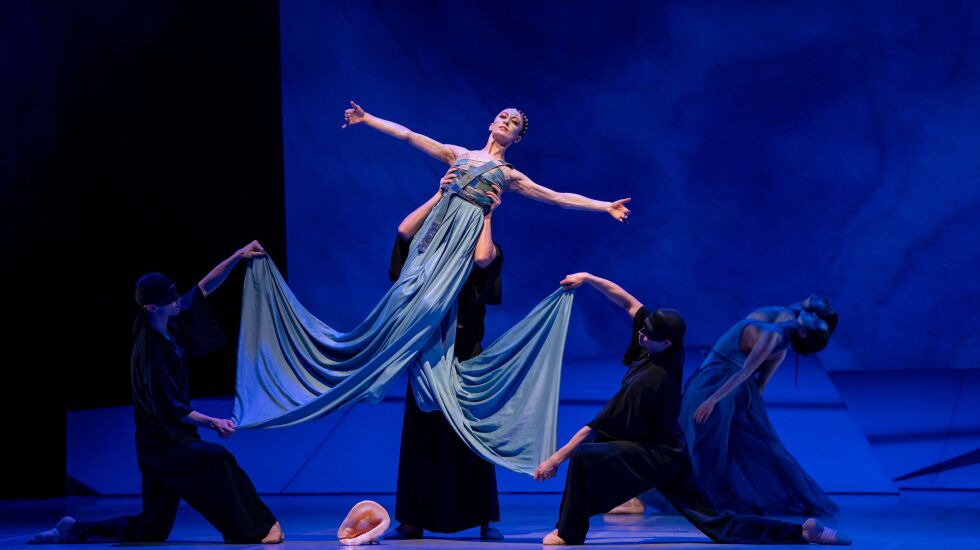
To understand and appreciate the Joffrey Ballet’s new production of “The Little Mermaid,” it’s important first of all to understand that it has little to do with Walt Disney’s hugely successful if anodyne animated version from 1989.
Much more in keeping with the darkness of Hans Christian Andersen’s 1837 fairy tale, this nearly 2½-hour adaptation is meditative, intense, unsettling and sometimes even grim. It is also unfailingly entrancing and beautiful.
While largely following the original plot, it adds the Andersen-like character of the Poet (Stefan Goncalvez), an odd, anachronistic and socially inept figure who shapes and intervenes in the tale that follows but also fearfully shirks from it at times.
So, as much as the ballet is a story of a mermaid who longs for love and pines to be human, it is also about the power of fantasy, imagination and words. The only real joy arrives at the very end, when the Poet and his mermaid creation come together in a mystical realm floating in the stars.
It is only then that there is a duet suggesting real connection, as the Poet and Little Mermaid (Victoria Jaiani) each clasp their hands above their bodies in a circular gesture, oscillating back and forth, the Poet then wrapping his circled arms around the Mermaid and resting them on her outstretched arms in the same pose.
“The Little Mermaid,” which premiered in 2005 at the Royal Danish Ballet, is a fresh, fiercely original work by John Neumeier, the longtime director and chief choreographer of the Hamburg Ballet. Although he has done away with the pantomime and formalism of the great story ballets of the past, the movement, though utterly contemporary, remains rooted in classical ballet, and he achieves a similar level of emotional potency.

The only knock on this work is that some of the scenes arguably run a bit long even when taking into account that the action is meant to be iterative as it sometimes reaches a kind of manic frenzy.
The semi-abstract sets, designed by Neumeier, who also served as costume and lighting designer, are both low and high tech. The deck of a cruise ship, for example, is simply and effectively suggested by a railing, the outline of steam chimneys and blue in the distance. Perhaps most striking are the suspended, curved lines of inlaid LED lights that elegantly evoke waves when combined with blue general lighting and a watery backdrop.
Also deserving note is Neumeier’s inventive solution to portraying a mermaid. Instead of some kind of prosthetic fish tail, the Little Mermaid wore billowy blue pants with huge bell bottoms that trailed 2 or 3 feet beyond her feet. The scene in which the devilish Sea Witch strips of her of these pants and the rest of her garb when she gives up her tail to become human could hardly be more gut-wrenching.
This ballet could not exist without the rich, deeply expressive score by Lera Auerbach, a Soviet-born Austrian American composer who shows herself to be every bit a successor in this realm to Tchaikovsky and Prokofiev.
With disorienting dissonances, eerie glissandos, angry percussion, thrusting brass, plaintive violin solos and punctuating, insistent piano strokes, the music is at once forlorn and raw, atmospheric and angry, entrancing and agitating.
Most unusual and perhaps the key ingredient is Auerbach’s use of the theremin, an electronic instrument invented in 1928. Players wave their hands near two antennas to create wavering, otherworldly sounds that are ideally suited to this ballet. Darryl Kubian offers a virtuosic performance here.
Conductor Scott Speck is in top form, propelling the ballet forward and drawing the absolute best from the Lyric Opera Orchestra, which delivers in-the-moment playing that piercingly conveys the music’s turbulent, ever-changing flavor.
This production also would not have been possible without the milestone, career-defining performances of the principals, starting with Jaiani, who is onstage for nearly the entire ballet in the title role and displays extraordinary endurance and commanding and unwavering stage presence.
There is much to praise, starting with her amazing technique and athleticism, which is shown again and again, including a combination in which she peers out from between the legs of the Prince and the rest of her body is flat against his back.
But most important is her ability to inhabit and project the feelings of the Little Mermaid, especially the character’s fear, doubt and vulnerability when she arrives essentially naked onshore about being transformed into a human. Her body is crumpled into itself and she tentatively extends and examines her new legs and wobbles as she tries to stand up.
At the same time, Yoshihisa Arai (retiring at the end of the 2022-23 season) could hardly be more menacing as the Sea Witch, with his white-and-black face paint and his lurking, crouching and serpentine moves. And Dylan Gutierrez is at his finest as the Prince, who is present in nearly every scene but still comes off as blithely disconnected to everyone including his wife.







